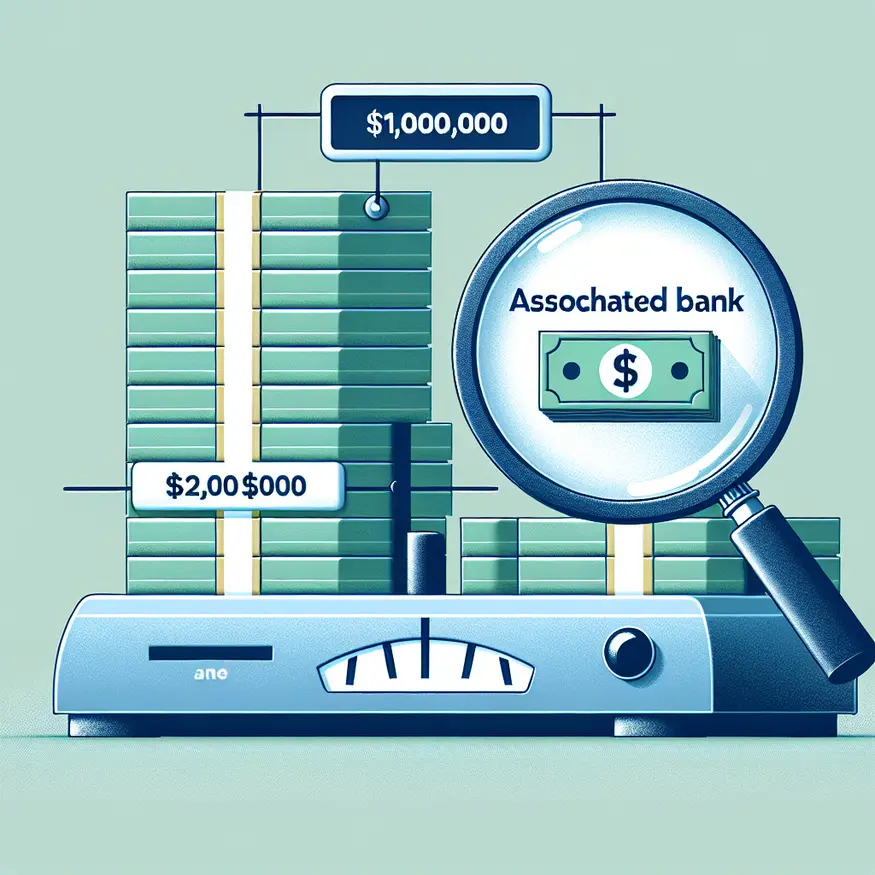Need Flexibility? Fifth Third Bank Offers Loans Starting at $1,000 for a Variety of Uses
Discover how Fifth Third Bank’s flexible loan options can help you manage your finances with ease.
Flexible loans starting at $1,000 for all your financial needs.
Looking for ways to borrow money can be stressful and overwhelming, especially when you need quick cash for unexpected expenses or big purchases. Many people face confusion about how to apply for loans and worry about hidden costs that accompany borrowing. If you’ve ever felt uncertain about the loan application process and its impact on your finances, you’re not alone.
Now, let’s break down everything you need to know about successfully applying for a loan and borrowing money wisely.
What You Will Learn
- Interest rates
- Monthly payments
- Loan fees
Understanding the loan application process is crucial to avoid unnecessary stress and financial pitfalls. In this article, you’ll find clear explanations and practical tips to make borrowing money simpler, faster, and more transparent. By the end, you’ll know how to judge the best loan offers, calculate what monthly payments fit your budget, and uncover fees that lenders may charge.
Interest rates
Interest rates determine the cost of borrowing money and significantly influence the total amount you will repay. It’s essential to evaluate these rates carefully before submitting a loan application.
Continue reading
-

First Citizens Bank Loans Starting at $3,000: A Useful Option for Many Needs
-

Borrow Between $4,000 and $10,000 with Bank of America Personal Loans
-

Wells Fargo Loans Starting at $2,500 – Learn How to Apply
-

See What a $5,000+ Personal Loan with KeyBank Could Help You Accomplish
-

Applying for a Personal Loan at JPMorgan Chase Starting at $2,500
1. Understand the Types: Loans may have fixed or variable interest rates. Fixed rates stay the same throughout the repayment period, offering predictability. Variable rates can fluctuate based on market conditions, which might lower or increase your payments.
2. Compare Offers: Different lenders offer diverse interest rates depending on your credit score, loan amount, and duration. Always request quotes from multiple institutions to find the best deal.
3. Know Your Credit Score: A better credit score usually means a lower interest rate. Check your credit report in advance to correct any errors that might impact your loan application.
4. APR vs. Interest Rate: Annual Percentage Rate (APR) includes interest and most fees, providing a clearer picture of the loan’s total cost. Prioritize comparing APRs rather than just interest rates.
5. Negotiate When Possible: Some lenders allow negotiation on rates, especially if you have strong credit or an existing relationship with the bank. Don’t be afraid to ask for better terms.
6. Beware of “Too Good to Be True” Rates: Extremely low-interest rates may come with conditions like higher fees or shorter borrowing terms. Read the fine print carefully before committing.
Monthly payments
Knowing how much you need to pay each month is vital for budgeting and ensuring your loan remains manageable. Let’s explore how monthly payments are calculated and what impacts them.
1. Loan Amount and Term: The principal amount borrowed and the repayment period directly influence monthly payments. Longer terms reduce monthly payments but increase total interest paid.
2. Interest Component: Monthly payments include principal repayment plus interest. Higher interest rates lead to larger payments.
3. Use Loan Calculators: Many banks provide online calculators where you input loan amount, term, and interest rate to estimate monthly payments. Use these tools to plan before applying.
4. Consider Your Budget: Calculate your total monthly income and expenses to ensure the loan payment fits comfortably without causing financial strain.
5. Watch for Prepayment Options: Some loans allow early repayment without penalties, which might let you reduce the total interest by paying off the loan faster.
6. Plan for Changes: Variable-rate loans can cause monthly payments to rise. Factor this possibility into your budget to avoid surprises.
7. Automatic Payments: Setting up automatic loan payments can help you avoid missed dues and maintain a good credit history.
Loan fees
Loan fees are additional costs that might not be immediately obvious but can impact the overall expense of borrowing money. Understanding these fees helps you avoid unexpected charges.
1. Origination Fee: This is a one-time charge for processing your loan application, usually a percentage of the loan amount. Some lenders waive this fee for special offers.
2. Application Fee: Some lenders charge a fee just to apply, regardless of loan approval. Confirm if this fee exists before starting your application.
3. Late Payment Fee: Missing payments can trigger penalties that add to your debt. Always pay on time or notify your lender if you face difficulties.
4. Prepayment Penalties: Certain loans charge a fee if you pay off your loan early, so double-check for this restriction if you plan to clear the debt ahead of schedule.
5. Credit Check Fee: Lenders often conduct a credit check during approval, and some may pass this cost to you, though many cover it themselves.
6. Renewal or Extension Fees: Extending your loan term might incur additional fees. Compare whether paying the extension is cheaper than late payments.
7. Hidden Charges: Read your loan agreement thoroughly to spot any minor or unusual fees that could accumulate over time.
Understanding and asking about loan fees can save you money and stress, making your borrowing experience more transparent and comfortable.
Practical Tips for a Successful Loan Application
Applying for a loan the right way increases your chances of approval and getting favorable terms. Here’s a step-by-step guide:
1. Gather Your Documents: Prepare identification, proof of income, credit reports, and bank statements. Having these ready speeds up the process.
2. Assess Your Needs: Determine exactly how much money you need and for what purpose. Avoid borrowing more than necessary.
3. Check Your Credit Score: Obtain your credit report and score from official sources, and correct any errors before applying.
4. Research Lenders: Look into banks, credit unions, and online lenders to compare offers, reviews, and customer satisfaction.
5. Prequalify When Possible: Some lenders allow prequalification to estimate chances of approval without affecting your credit score.
6. Complete the Application: Fill in all required information accurately and honestly to avoid delays or denials.
7. Review Terms: Read the loan contract carefully, focusing on interest rates, fees, and payment schedules.
8. Plan for Repayment: Set up reminders or automatic payments to stay on track and protect your credit rating.
Personal Loan at Wells Fargo 💰
How Borrowing Money Wisely Can Improve Your Financial Health
Borrowing money may seem like a necessary evil, but done correctly, it can help you build credit, cover essential expenses, or invest in your future.
1. Build Credit History: Timely loan repayments demonstrate financial responsibility, improving your credit score.
2. Manage Emergencies: Access to funds can help you cover unexpected medical bills or urgent repairs without draining savings.
3. Avoid High-Interest Debt: A well-structured personal loan often has lower interest rates compared to credit cards or payday loans.
4. Consolidate Debt: Use loans to combine multiple high-interest debts into one payment with better terms.
5. Invest in Opportunities: Borrowing money for education or starting a small business can create long-term benefits.
6. Maintain Cash Flow: Loans provide liquidity that helps you keep regular monthly expenses under control.
7. Plan Ahead: Always borrow within your means and understand your repayment schedule before committing.
Responsible borrowing empowers you, providing financial tools to reach your goals while avoiding common pitfalls.
Explore Personal Loans at Bank of America
Conclusion
In this article, you have learned the key aspects of applying for a loan and borrowing money wisely. Understanding interest rates, monthly payments, and loan fees puts you in control of your finances and helps you make informed decisions. By following the guidelines and tips provided, you can navigate the loan application process with confidence, avoid surprises, and choose the best option for your needs.
Ready to take the next step in managing your financial journey? Dive into our next article for more insights and resources to keep you empowered and financially sound.

Need Flexibility? Fifth Third Bank Offers Loans Starting at $1,000 for a Variety of Uses
Looking for ways to borrow money can be stressful and overwhelming, especially when you need quick cash for unexpected expenses or big purchases. Many people face confusion about how to apply for loans and worry about hidden costs that accompany borrowing. If you’ve ever felt uncertain about the loan application process and its impact on […]

From $1,000 to $25,000: Associated Bank Loans You Might Not Know About
Finding the right bank loan can feel overwhelming, especially when you’re juggling bills, unexpected expenses, or planning for the future. Many people struggle with confusing loan offers and unclear terms, leaving them uncertain about which option fits their needs best. If you’re seeking clarity and confidence in choosing a loan, you’re not alone. Let’s dive […]

Santander Loans Starting at $2,000: Helping People Handle More Than Emergencies
When unexpected expenses arise or a financial opportunity knocks, finding the right loan can be both a relief and a challenge. Many people feel overwhelmed by the choices between personal loans and traditional bank loans, unsure of what fits their needs best. Understanding these options can help you take control of your financial future with […]